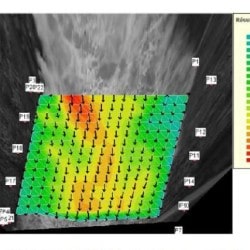Home › Forums › Environmental Sensors › Large Particle Velocity Measurement
Tagged: computer vision, Velocity Measurement
- This topic has 2 replies, 3 voices, and was last updated 2016-03-11 at 1:31 AM by
 Andrew.
Andrew.
-
AuthorPosts
-
-
2016-02-18 at 1:28 PM #1380
I was wondering if anybody was trying out this idea of a floating particle velocity measurement – here is a picture of a stream, with a surface velocity vector field

The technology enablers are that the computer vision industry is maturing with its software, and it might be possible to translate this to measure particles floating on water.
In addition if the particles could be differentiated between leaves and woody debris, and items that are garbage – it could possibly count pollution especially at flood level.
I attach an overview of the technique Image-based velocity measurements from a conference in 2014. The summary is its using computer vision to detect particles moving on the surface of a stream. They supply a reference to the open source software that they have developed. (I haven’t tried it)
https://floodscale.irstea.fr/ – https://forge.irstea.fr/projects/fudaa-lspiv
the OpenCV.org software might also be adapted,
There is also an industry alliance that has formed around embedded vision (low cost)
embedded-vision.com -
2016-02-29 at 6:54 PM #1385
I am thinking of using surface imaging for supplementing traditional velocity-meter based flow measurements at high river stage. It appears that a research group has developed an app to do this in IOS. I haven’t been able to test output from the app against velocity-meter based observations, but we were able to get plausible results the first time we tried it. This seems like a promising technology, particularly in settings where high quality velocity measurements are impractical to collect.
More background is provided in this 2015 IAHR conference paper.
-
2016-03-11 at 1:31 AM #1406
-
-
AuthorPosts
- You must be logged in to reply to this topic.

 Welcome to EnviroDIY, a community for do-it-yourself environmental science and monitoring. EnviroDIY is part of
Welcome to EnviroDIY, a community for do-it-yourself environmental science and monitoring. EnviroDIY is part of 